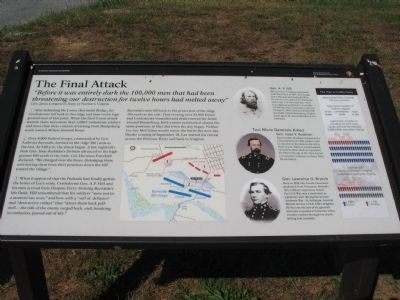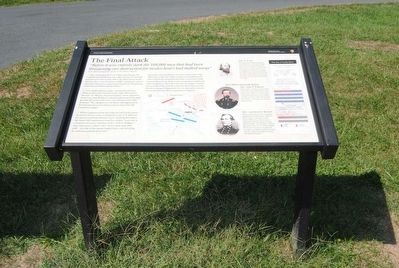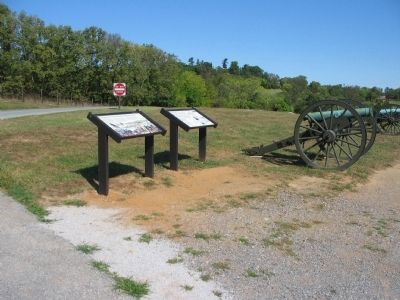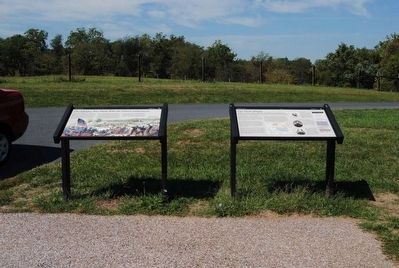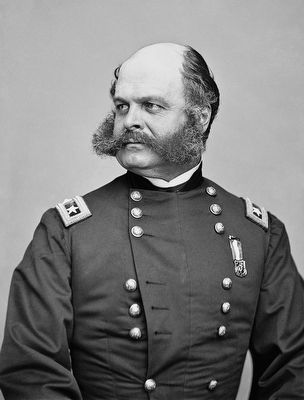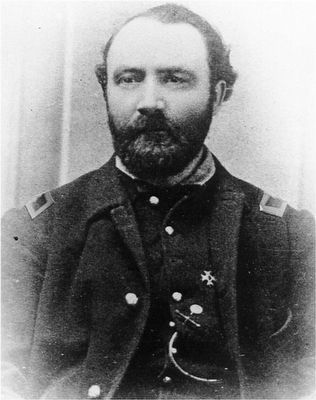Near Sharpsburg in Washington County, Maryland — The American Northeast (Mid-Atlantic)
The Final Attack
"Before it was entirely dark the 100,000 men that had been threatening our destruction for twelve hours had melted away"
Gen. James Longstreet, Army of Northern Virginia
(1) After defending the Lower (Burnside) Bridge, the Confederates fell back to this ridge and then to the high ground west of this point. When the final Union attack started, there were more than 2,000 Confederate soldiers and more than forty cannon stretching from Sharpsburg south toward Millers Sawmill Road.
(2) Over 8,000 Federal troops, commanded by Gen. Ambrose Burnside, formed on the ridge 300 yards to the east. At 3:00 p.m., the attack began. A few regiments from Gen. Isaac Rodman's division advanced to the high ground 400 yards to the west. Col. Harrison Fairchild declared, "We charged over the fence, dislodging them and driving them from their position down the hill toward the village."
(3) When it appeared that the Federals had finally gotten the better of Lee's army, Confederate Gen. A.P. Hill and his men arrived from Harpers Ferry. Striking Burnside's left flank, Hill remembered that his soldiers "were not in a moment too soon," and how with a "yell of defiance" and "destructive volleys" they "drove them back pell-mell...the tide of the enemy surged back, and, breaking in confusion, passed out of site."
Burnside's men fell back to the protection of the ridge 300 yards to the east. That evening over 23,000 Union and Confederate wounded and dead covered the fields around Sharpsburg. Both armies maintained almost the same positions as they did when the day began. Neither Lee nor McClellan would renew the battle the next day. On the evening of September 18, Lee started his retreat across the Potomac River and back to Virgina.
Gen. A.P. Hill
Hill was born in Virginia, graduated from West Point in 1847, then fought in the Mexican and Seminole Wars. He was in every major Civil War battle in the east. Lee once said that, "next to Longstreet and Jackson, I consider A.P. Hill the best commander with me." On April 2, 1865, Ambrose Powell Hill was killed outside Petersburg, Virginia at the age of 39, one week before Lee's surrender.
Two More Generals Killed
Gen. Isaac P. Rodman
Born in 1822, Rodman commanded a Union division of 3,200 soldiers until he was shot in the chest on the hill in front of you. Taken to a field hospital, General Rodman died on September 20, 1862 at the age of 40. He is buried in his family's cemetery in Peace Dale, Rhode Island.
Gen. Lawrence O. Branch
Born in 1820, this North Carolinian graduated from Princeton. Branch's only military experience before the Civil War was a short stint as a general's aide during the Second Seminole War. At Antietam, General Branch led one of A.P. Hill's brigades. He became the last of six generals mortally wounded at Antietam when a bullet crashed through his cheek, killing him instantly.
The Day is Finally Done
Approximate Time of Action 3:00 p.m. to Sunset
Approximate Number of Soldiers Engaged:
Union 8,000
Confederate 4,500
Total 12,500
Approximate Number of Casualties for Each Army:
Union Army of the Potomac
2,200 killed, wounded, missing
Confederate Army of Northern Virginia
1,000 killed, wounded, missing
Erected 2009 by Antietam National Battlefield - National Park Service - Department of the Interior.
Topics. This historical marker is listed in this topic list: War, US Civil. A significant historical date for this entry is September 17, 1862.
Location. This marker has been replaced by another marker nearby. It was located near 39° 27.211′ N, 77° 44.356′ W. Marker was near Sharpsburg, Maryland, in Washington County. Marker was on Branch Avenue, on the left when traveling south. Located at stop 10, the Final Attack, of the driving tour of Antietam Battlefield. Touch for map. Marker was in this post office area: Sharpsburg MD 21782, United States of America. Touch for directions.
Other nearby markers. At least 10 other markers are within walking distance of this location. The Advance Was Made With the Utmost Enthusiasm (here, next to this marker); Brown’s (Wise), Virginia Battery (a few steps from this marker); The Fate of the Army (a few steps from this marker); “Forever Free” (a few steps from this marker); “It Is A.P. Hill” (a few steps from this marker); Ninth Army Corps (within shouting distance of this marker); a different marker also named Ninth Army Corps (within shouting distance of this marker); D.R. Jones' Division, Longstreet's Command (within shouting distance of this marker); a different marker also named D.R. Jones' Division, Longstreet's Command (within shouting distance of this marker); Longstreet's Command (within shouting distance of this marker). Touch for a list and map of all markers in Sharpsburg.
More about this marker. In the lower center is a map showing the actions (keyed to the text) in this phase of the battle. To the right are portraits of Gens. Hill, Rodman, and Branch.
Related markers. Click here for a list of markers that are related to this marker. Old Marker At This Location titled "It is A.P. Hill" and New Markers At This Location titled "The Fate of the Army".
Also see . . .
1. Ambrose Burnside. Ambrose Everett Burnside (May 23, 1824 – September 13, 1881) was an American soldier, railroad executive, inventor, industrialist, and politician from Rhode Island, serving as governor and a United States Senator. As a Union Army general in the American Civil War, he conducted successful campaigns in North Carolina and East Tennessee, as well as countering the raids of Confederate General John Hunt Morgan, but suffered disastrous defeats at the terrible Battle of Fredericksburg and Battle of the Crater. (Submitted on October 5, 2015, by Brian Scott of Anderson, South Carolina.)
2. Isaac P. Rodman. Isaac Peace Rodman (August 18, 1822 – September 30, 1862) was a Rhode Island banker and politician, and a Union Army brigadier general in the American Civil War, mortally wounded at the Battle of Antietam. (Submitted on October 5, 2015, by Brian Scott of Anderson, South Carolina.)
3. Col. Harrison Fairchild Biography. The Eighty Ninth New York Volunteer Infantry website entry:
4. A.P. Hill. Ambrose Powell Hill, Jr. (November 9, 1825 – April 2, 1865) was a Confederate army general who was killed in the American Civil War. (Submitted on October 5, 2015, by Brian Scott of Anderson, South Carolina.)
5. Lawrence O. Branch. Lawrence O'Bryan Branch (November 28, 1820 – September 17, 1862) was a North Carolina representative in the U.S. Congress and a Confederate brigadier general in the American Civil War, killed at the Battle of Antietam. (Submitted on October 5, 2015, by Brian Scott of Anderson, South Carolina.)
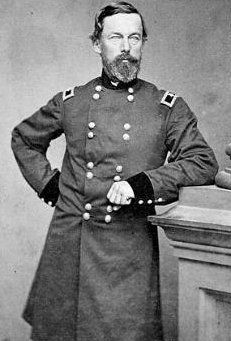
Photographed By Brian Scott
6. Brig. General Isaac P. Rodman (1822-1862)
At 4:00 p.m. A.P. Hill's Light Division joined the battle, launching a spirited counterattack after a rapid forced march from Harpers Ferry. Sighting the approaching Confederates, Rodman knew his division, on the Union army's left flank, would take the brunt of their assault. Galloping across a cornfield to warn his brigade commanders, he was shot through the left lung, mortally wounded. He died thirteen days later in a field hospital at Sharpsburg.
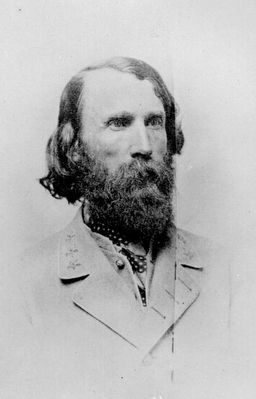
Photographed By Brian Scott
8. Lieutenant General A.P. Hill (1825-1865)
Responding to an urgent call for assistance from Lee, Hill marched his men at a grueling pace and reached the battlefield just in time to counterattack a strong forward movement by the corps of Maj. Gen. Ambrose Burnside, which threatened to destroy Lee's right flank. Hill's arrival neutralized the threat, bringing an end to the battle with Lee's army battered but undefeated.
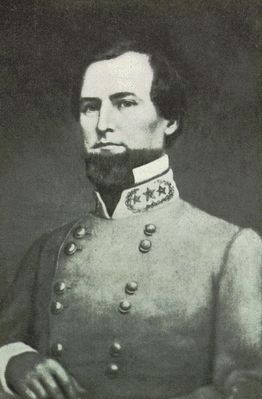
Photographed By Brian Scott
9. Brig. General Lawrence O'Bryan Branch (1820-1862)
On September 17, 1862, he led his troops on a rapid march from Harpers Ferry to Sharpsburg, Maryland where the Battle of Antietam was raging. Branch arrived on the field around 2:30 PM, in time to help stop the Union advance, thus saving General Robert E. Lee's right flank from a crushing defeat. Soon after this victory, Branch stood talking with fellow brigadier generals Maxcy Gregg, Dorsey Pender, James J. Archer, along with Hill and General Lee when a Federal sharpshooter, seeing the group, fired a shot that hit him in the right cheek and exited behind his left ear, killing him instantly. He fell dead into the arms of a staff officer.
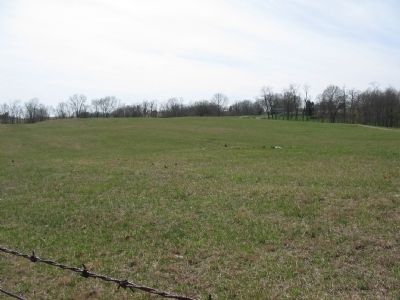
Photographed By Craig Swain, March 29, 2008
10. High Ground West of Branch Avenue
Federal forces advanced up the slopes of the ground west of (modern) Branch Avenue in the final stages of the battle. The arrival of A.P. Hill's Division turned the flanks of the Federals and effectively ended the battle.
Credits. This page was last revised on April 4, 2023. It was originally submitted on September 22, 2009, by Craig Swain of Leesburg, Virginia. This page has been viewed 1,280 times since then and 23 times this year. Photos: 1. submitted on September 22, 2009, by Craig Swain of Leesburg, Virginia. 2. submitted on October 5, 2015, by Brian Scott of Anderson, South Carolina. 3. submitted on September 22, 2009, by Craig Swain of Leesburg, Virginia. 4, 5, 6, 7, 8, 9. submitted on October 5, 2015, by Brian Scott of Anderson, South Carolina. 10. submitted on September 22, 2009, by Craig Swain of Leesburg, Virginia.
